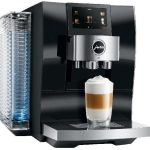It is far okay if you love your espresso machine more than anything in the world. You treat it with care and respect because you always expect it to reward you with delicious shots of liquid gold every morning.
But wait: sometimes, things go wrong, and they may do. Your espresso starts to taste bitter, your machine makes weird noises, or worse, or it stops working altogether. Suspecting what’s going on?
The culprit is likely to be scale. Scale is the buildup of minerals from your water that can clog up your machine’s pipes and heating element. That can severely degrade the performance and worsen the taste of your espresso, and can even damage your machine if left untreated. That is the main reason why you need to descale your espresso machine regularly.
But don’t worry, descaling is not as hard as it sounds. In fact, it can be quite fun if you follow these simple steps and add some humor to the process. Here’s how to descale espresso machine without losing your mind.

How To Descale Espresso Machine in 5 Easy Steps
Only five steps away and you get a nice and tastiest espresso dripping right into the cup to make you feel fresh and charged.
Step #1: What You’ll Need
- A descaling solution or white vinegar
- One large container or mug
- And, a piece of cloth or sponge
Step #2: Prepare Your Machine
Before you start descaling, you need to prepare your machine for the process.
First, turn on your machine and let it heat up to full boiler pressure. Then, turn the machine off and let it cool down for a while. This will make sure that the descaling solution can reach all the parts of your machine.
Next, empty the water tank and fill it with your descaling solution or white vinegar. If you’re using vinegar, mix one part vinegar and one part water. And, when going with a descaling solution? You should not forget to follow the instructions on the packet.
Now, place a large container or mug under the portafilter and open the hot water valve. Run some water through the portafilter until the container is full. Then, close the valve and empty the container. Repeat this process until you see the water tank is fully empty. This will flush out any coffee grounds and oils from the group head and the portafilter. It will also start to dissolve the scale from the pipes and the boiler.
Step #3: Soak It Well!
Now that you’ve run some descaling solution through your machine, you need to let it soak for a while. This will allow the solution to work its magic and break down the stubborn scale deposits.
Depending on how dirty your machine is, you may need to let it soak for 15 minutes to an hour. You can use this time to do something else, like read a book, watch a show, or write a blog post about descaling an espresso machine.
But don’t forget about your machine! Set a timer or an alarm to remind you when it’s time to rinse it.
Step #4: Rinse It Out
After letting your machine soak, it’s time to rinse it out with fresh water. It will remove any traces of the descaling solution or vinegar from your machine.
First off, fill the water tank with clean water and run it through the portafilter and the hot water valve until the tank is empty. You may need to do this several times until the water comes out clear and odorless.
Make sure to check the color and smell of the water as you rinse. If it’s still cloudy or sour, that means there’s still some scale or vinegar left in your machine. Keep rinsing until you’re satisfied with the results.
Step #5: Clean It… Cleant it Well!
You’re almost done in the process! Only the last step remains where you need to clean up your machine and make it shine.
To do this, wipe down the exterior of your machine with a damp cloth or sponge. Pay attention to any spots or stains that may have formed during the descaling process.
Then, remove the porta filter and clean it with soap and water. Upon needing, use a brush or a pin to remove any coffee grounds from the holes of the filter basket.
Finally, reassemble your machine and enjoy a fresh cup of espresso. And, you’ve just finished descaling your espresso machine with all peace of mind!
Congratulations!
Congrats as you’ve successfully completed one of the most important tasks for maintaining your espresso machine. By descaling regularly, you’ll ensure that your machine performs well and delivers great-tasting coffee every time.
But don’t get too comfortable! Descaling is not a one-time thing. Depending on how often you use your machine and how hard your water is, you may need to descale every two to four months.
So keep an eye on your machine and look out for any signs of scale buildup, such as reduced water flow, lower pressure, or bitter taste. And when in doubt, just follow these steps cited in how to descale espresso machine once again and the machine will start serving just like brand new.
Happy brewing!
Descaling Solution vs Vinegar: Which One to Pick?
You may be wondering which is better for descaling your espresso machine: a commercial descaling solution or white vinegar. Both have their pros and cons, and the choice ultimately depends on your preference and budget.
A descaling solution is a product that is specifically formulated to dissolve mineral buildup without damaging your machine. It retains a more neutral pH level than vinegar, which makes it gentler on the materials of your machine. And, it also has a less noticeable smell and taste than vinegar, which means you won’t have to rinse your machine as much to get rid of it.
However, a descaling solution can be more expensive and harder to find than vinegar. You may have to order it online or go to a specialty store to get it. But always sneak peek onto following the instructions written on the packet carefully, as different solutions may have different concentrations and dosages.
Descaling espresso machine with vinegar, on the other hand, is a cheap and natural alternative that you probably already have in your kitchen. It’s an acetic acid that can break down mineral deposits, but not as effectively as a descaling solution. Thus, a strong smell and taste can linger in your machine and affect the flavor of your coffee. You may have to rinse your machine more times to get rid of it.
Moreover, vinegar can be harsh on your machine if used too often or left in for too long. It can corrode the metal parts of your machine and void the warranty if the manufacturer does not recommend it. Always check the manual of your machine before using vinegar to descale it.
So, which one should you use? And the winner is: it depends.
Wanting to have a better effective and gentle method to descale your machine, and you also don’t mind spending some extra money, then a descaling solution should be your way to go. But if you decide to run with a more natural and affordable way to descale your machine, and you don’t mind the smell and taste of vinegar, then vinegar is a good option.
But whichever method you choose, make sure to do it regularly and follow the steps above to keep your espresso machine in tip-top shape. And don’t forget to add some humor to make it more fun!
Jura Espresso Machines are the most durable and efficient coffee machines, suitable for home and professional usage. Read our reviews of Jura E8, Jura Impressa Z6, Jura S8 and Jura Z10 that will help you in selecting the Jura that meets your requirements.









No comments yet.